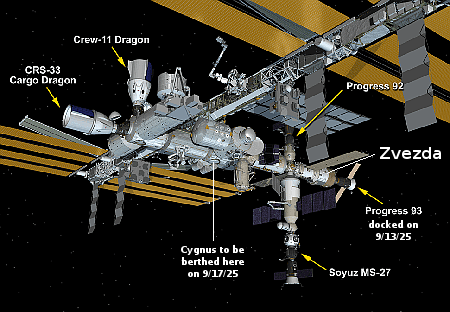Progress docks safely with Zvezda module at ISS

ISS as of today. Click for original.
In what is increasingly a worrisome procedure, Russia’s just launched Progress freighter successfully docked with the aft port of the Zvezda module at ISS this past weekend, bringing with it more than 5,000 pounds of supplies and research equipment.
The image to the right, annotated additionally by me, shows the present configuration of spacecraft at ISS. The concerns center on the stress fractures that have been found in the Zvezda hull, fractures that have caused the air leak on ISS and are believed attributable to the many dockings to the module since its launch in the late ’90s, as well as the module’s age. It was first built in the late ’80s, making it almost four decades old.
For recent dockings, NASA now closes the hatch between the Russian and American halves of the stations, just in case Zvezda experiences a catastrophic failure. The Russians seem less concerned, but nonetheless they also take extra care during dockings. It is my understanding their astronauts prepare their Soyuz capsule as a lifeboat and immediately escape during these operations.

ISS as of today. Click for original.
In what is increasingly a worrisome procedure, Russia’s just launched Progress freighter successfully docked with the aft port of the Zvezda module at ISS this past weekend, bringing with it more than 5,000 pounds of supplies and research equipment.
The image to the right, annotated additionally by me, shows the present configuration of spacecraft at ISS. The concerns center on the stress fractures that have been found in the Zvezda hull, fractures that have caused the air leak on ISS and are believed attributable to the many dockings to the module since its launch in the late ’90s, as well as the module’s age. It was first built in the late ’80s, making it almost four decades old.
For recent dockings, NASA now closes the hatch between the Russian and American halves of the stations, just in case Zvezda experiences a catastrophic failure. The Russians seem less concerned, but nonetheless they also take extra care during dockings. It is my understanding their astronauts prepare their Soyuz capsule as a lifeboat and immediately escape during these operations.












